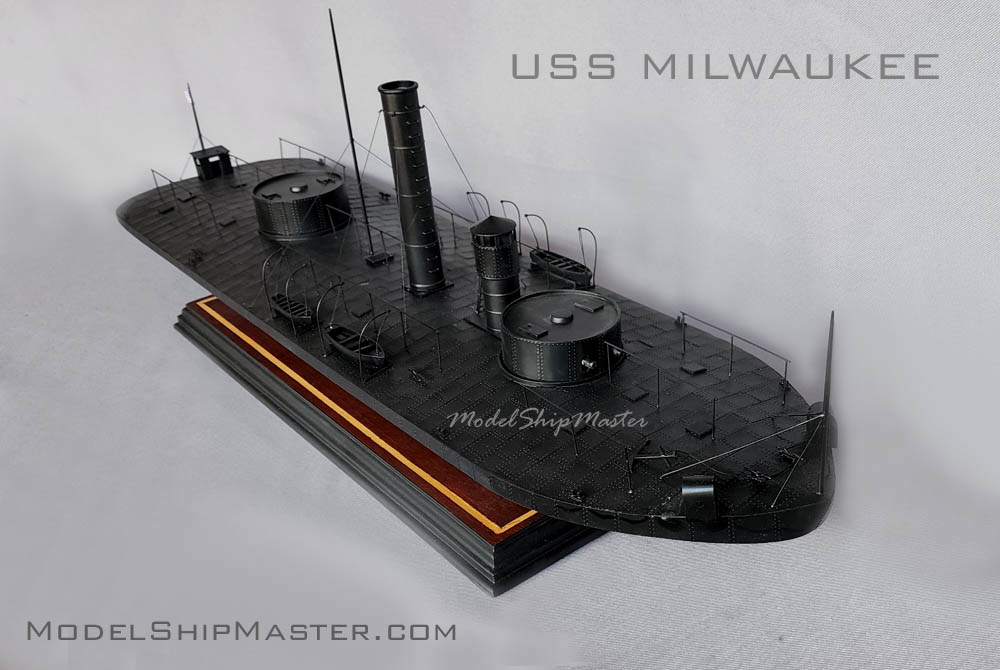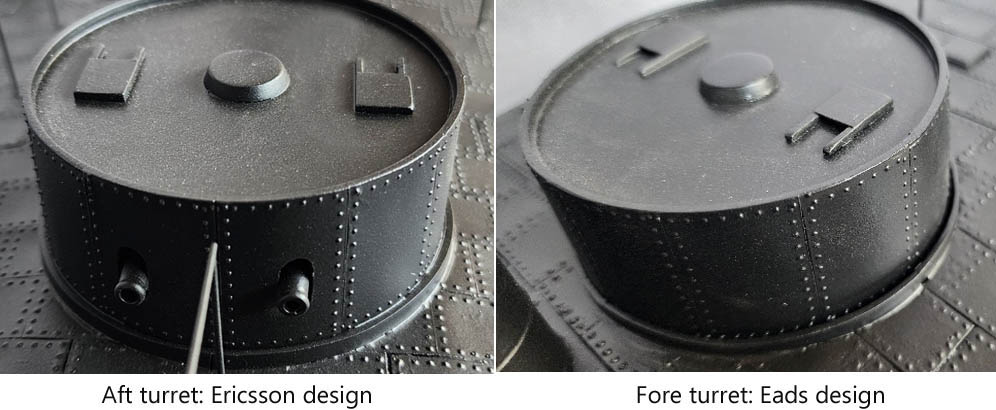
The Milwaukee-class monitors were a class of four
riverine ironclad monitors built during the American
Civil War. Several supported Union forces along
the Mississippi River in mid-1864 before participating
in the Battle of Mobile Bay in August. Milwaukee struck
a torpedo during this time and sank. The surviving three
ships were sold in 1874; Chickasaw was converted into
a ferry and survived until 1944 when she was scuttled.

The
ships' main armament consisted of four smoothbore
11-inch Dahlgren guns mounted in two twin-gun
turrets. The fore turret in each ship, except
Chickasaw, was designed by Eads, while the aft
turret was the standard Ericsson design used in most
Union monitors. Unlike the latter, which rested its
entire weight on a central spindle that had to be
elevated in order for the turret to rotate, Eads'
design better distributed its weight because it
rested on a number of ball bearings underneath the
outer edge of the turret. The structure of the Eads
turret extended down to be bottom of the ship and
the entire structure rotated. The guns in the Eads
turret were mounted on a steam-powered platform that
moved up and down, so that the guns could be
reloaded below deck, safe from enemy interference.
The ability to adjust the level of the turret floor
doubled the elevation of the guns to +20° compared
to the +10° allowed in an Ericsson turret. Another
advantage was that the Eads turret only required a
crew of six men, far fewer than the Ericsson design.
Each gun weighed approximately 16,000 pounds. They
could fire a 136-pound shell up to a range of 3,650
yards.

The
cylindrical turrets were protected by eight layers
of wrought iron 1-inch plates above the deck. The
sides of the hull consisted of three layers of
one-inch plates, backed by 15 inches of pine. The
deck was heavily cambered to allow headroom for the
crew on such a shallow draft. Milwaukee and
Winnebago had an additional layer of armor to give
them a total of 1.5 inches. The pilothouse,
positioned behind and above the fore turret, was
protected by 3 inches of armor.
The
Milwaukee
was laid down on 27 May 1862 at
Carondelet, Mo. and commissioned at Mound City,
Ill., on 27 August 1864. Milwaukee was 229 feet long
and displaced 1,300 long tons. Her crew numbered 138
officers and enlisted men. The engines were designed
to reach a top speed of 9 knots (10 mph). Milwaukee
carried 156 long tons of coal.
Milwaukee was initially
assigned to the Mississippi Squadron upon
commissioning but saw no action. On 1 October 1864,
Rear Adm. David D. Porter, commanding the
Mississippi Squadron, ordered USS
Milwaukee to Mobile,
Ala., and report to Rear Adm. David G. Farragut for
duty with the West Gulf Blockading Squadron. The
ship departed Mound City, Illinois on 15 October and
arrived at New Orleans, Louisiana 12 days later.
Rear Adm. Farragut’s decisive
victory at Mobile Bay on 5 August 1864 had
essentially closed that port to the South, but the
city still lay in Confederate hands. To defend it,
the South heavily mined the shallow water that led
to the city, filled it with formidable obstructions
and erected batteries to shell any ships that had
managed to penetrate the fixed defenses.
New Year’s Day
found USS
Milwaukee in Mobile Bay
ready for action. In the following months, with
other light‑draft Union ships, she swept mines,
bombarded Confederate works, removed obstructions
and transported Army troops.
On 27 March
1865, Milwaukee, together with several other Union
ships, sortied upriver in an attempt to cut
communications between Spanish Fort and Mobile. The
following day she and her sister ship Winnebago
steamed up the Blakely River to attack a Confederate
transport and forced it to retreat. While returning
downriver Milwaukee struck a mine in an area
previously swept. She remained afloat forward, which
permitted her crew to escape without loss. Another
of her sisters, Kickapoo, rescued the survivors.